Since April 2023, we’ve managed to boost SEOTesting’s organic traffic from approximately 2,000 visits per month, to over 15,000 visits per month.

How did we do this? By using keyword clustering when writing our blog content.
In this blog, we’ll explain what keyword clustering is and how it can benefit your SEO performance. We’ll then uncover some different keyword clustering methods you can try out for yourself. We’ll also talk about how you can cluster your keywords manually and how you can cluster keywords using tools. You’ll then learn how to use URL switch tests to check whether keyword clusters are working and how content groups can be used to monitor their performance over time.
What is keyword clustering?
Keyword clustering is a term used to describe a group of keywords/queries that a single piece of content ranks for. This process removes the need for marketers and copywriters to publish one single piece of content for each keyword they want to target, saving:
- Time
- Money
- Effort
Instead, you can conduct keyword research and then categorize your keywords into relevant groups known as clusters. This means you only need one piece of content to target each cluster.
Here’s an example of how this looks on a website:
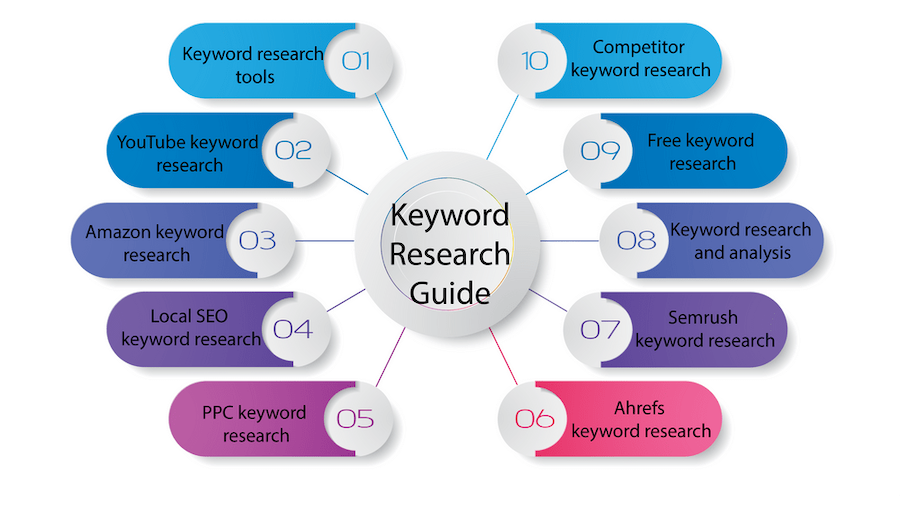
The content is focused on one particular keyword, in the example above it is keyword research guide. From there, there are several other keywords included in the cluster including examples like:
- Keyword research tools
- YouTube keyword research
- Local SEO keyword research
- PPC keyword research
Why does keyword clustering work?
Keyword clustering works because it utilizes the relationships between keywords to create organized, related groups of content. This method leverages the way search engines now process and rank content that is topically relevant and comprehensive, rather than solely focusing on keyword matches.
Here’s why keyword clustering is so effective:
Improved topical relevance: By grouping related keywords, you can create content that addresses a broader spectrum of a topic. This helps to enhance the topical relevance of your content, and makes it more likely to rank well for a variety of related search queries.
Better user experience: When content is structured around keyword clusters, it offers users a more coherent and valuable experience. They can find answers to multiple questions in one place, which reduces their need to search elsewhere and land on competitor websites.
Optimized for search intent: When you put together keyword clusters, you can better understand and cater to different user intents within the same topic. Covering various aspects of a topic can satisfy informational, navigational, and transactional search intents, which is essential to ensure your content ranks across different stages of the user journey.
Content creation efficiency: Rather than the “old” process of creating one piece of content for each keyword, clustering allows you to cover multiple keywords with fewer pages. This saves you time and money and helps build a more authoritative site structure.
Internal linking opportunities: Keyword clusters naturally make it easier for you to create a strong internal link structure. Linking between related content strengthens your site’s topical relevance and helps search engines understand the context and importance of different pages.
Keyword clustering examples
There are two different types of keyword clustering – semantic keyword clustering and SERP keyword clustering.
Below, we’ll explain these two approaches to grouping your keywords, to help you decide which method is best for your business.
Semantic keyword clustering
Semantic keyword clustering is a technique for grouping related keywords based on their meanings and context, rather than just matching words that look similar.
Let’s say, for example, that you’re creating content for a fitness website. Instead of targeting just one keyword like “exercise routines,” you could use semantic keyword clustering to group related keywords together, such as:
- Best workouts for beginners
- Effective home exercises
- How to start a fitness plan
- Strength training tips
- Cardio exercises for weight loss
These keywords all relate to the broader topic of exercise routines, but each addresses a specific area of the topic. Creating a single, comprehensive article (or a small series of articles) that covers all of these related topics can attract more visitors searching for related information.
Here’s how this would look in action:
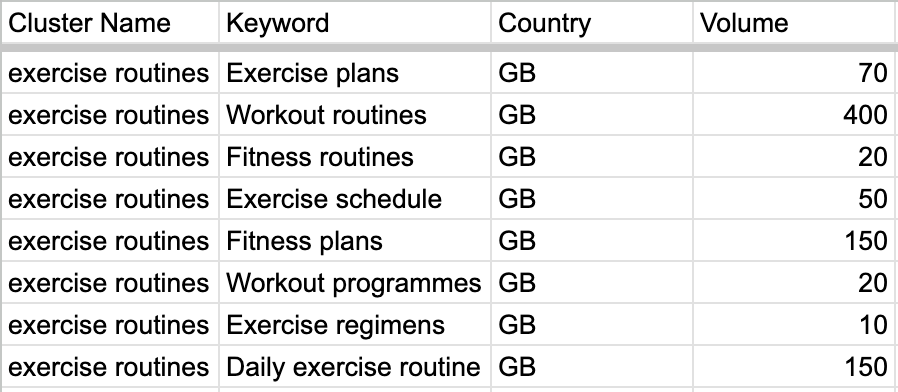
SERP keyword clustering
SERP keyword clustering is a method of clustering whereby keywords are grouped together based on how they appear on search engine results pages.
If different keywords lead the user to similar search results, it likely means that the same page can be used to target these multiple keywords. By clustering these keywords, you can create content that targets multiple search terms at once, improving your chances of ranking higher for a range of related queries.
Let’s say you worked in marketing for a travel company, and wanted to create content for tourist attractions in Paris. It’s likely that you can make one piece of content to target several keywords in that sector.

The above screenshot shows a SERP similarity of 73.68% between the following keywords:
- Paris tourist spots
- Top attractions in Paris
This means there is a good chance you could create one piece of content to target both of these keywords.
How to create keyword clusters manually
Before we explain how to create keyword clusters using tools, we’ll show you how to do it manually and at a low cost.
As long as you have access to spreadsheet software such as Microsoft Excel or Google Sheets, ChatGPT, and a rank tracker, you can follow the steps below:
Step 1: Build a list of keywords
First, you’ll need to build a list of keywords/queries you want to target with your content. This list of keywords will come from different sources, including:
- Speaking to customers
- Google Search Console/SEOTesting
- Ahrefs
- Google Keyword Planner
- Semrush
- Google Analytics
You’ll need to build a detailed list of both long-tail and short-tail keywords that cover different intents to ensure you create content for all users at every stage of the funnel.
Looking for a good place to start? You can use Ahrefs’ Keyword Explorer and type in a head keyword. For example, I typed in running shoes and searched for them in the US. Next, head to the Matching Terms section, and Ahrefs will provide you with a massive list of keywords to start you off.
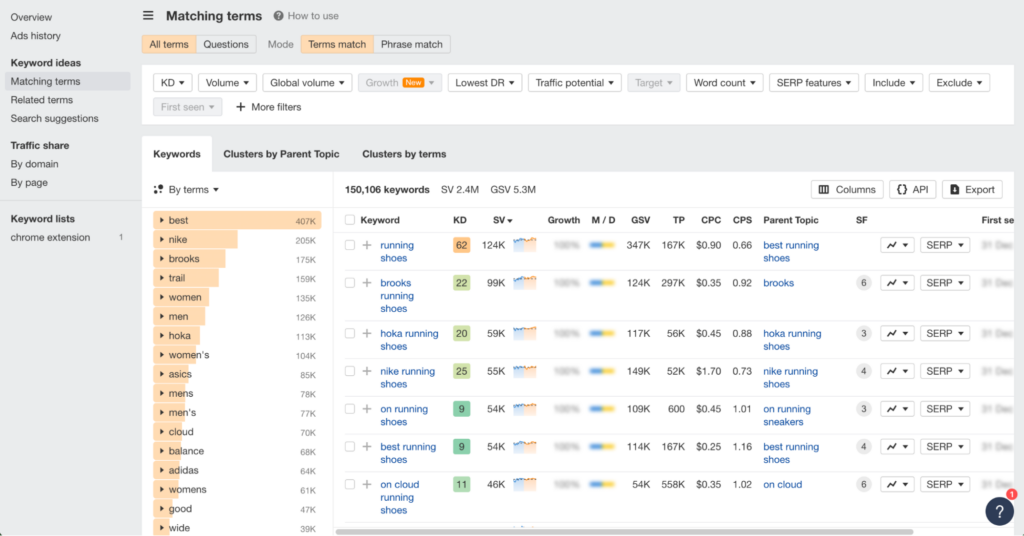
You can export this to start your keyword list on the right track, giving you a spreadsheet of different keywords with different search intents:
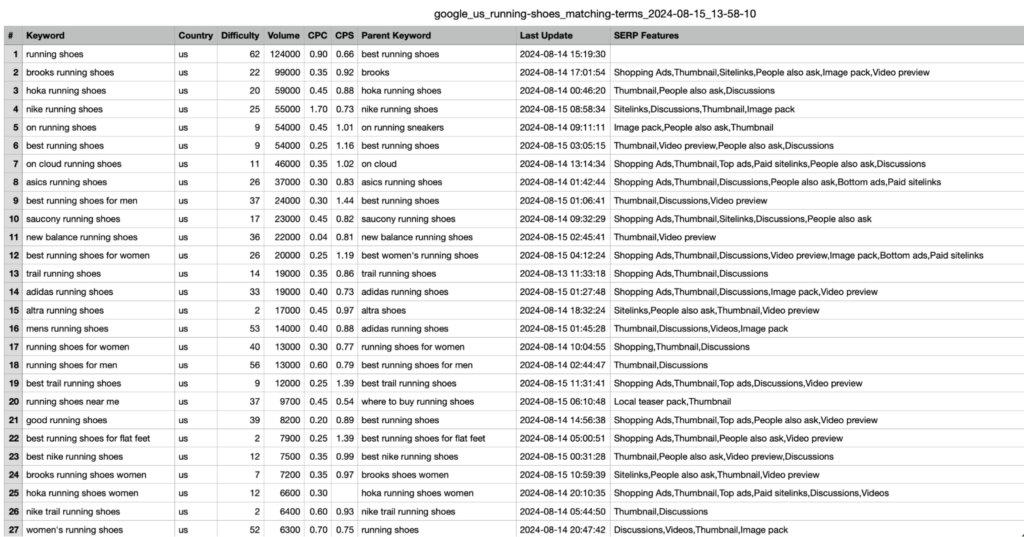
Use all the keyword research resources listed above to find other related keywords, add them to your spreadsheet, de-duplicate them, and you’ll have an exhaustive list of keywords around the topic to work with.
Step 2: Categorize your keywords by search intent
Your next step is to categorize your keywords by their search intent. All keywords/queries that you target will have one of four possible intents:
- Informational (The user is looking for information)
- Navigational (The user wants to be taken to a specific place)
- Commercial (The user is researching companies/products)
- Transactional (The user is looking to purchase something)
Identifying the intent of your keywords is important because it will inform the type of content you need to create. Informational blog posts won’t work for transactional queries, will they? So, you need to make sure that these are separated so your content has the best chance of success.
Luckily, ChatGPT can help speed this process up for you:
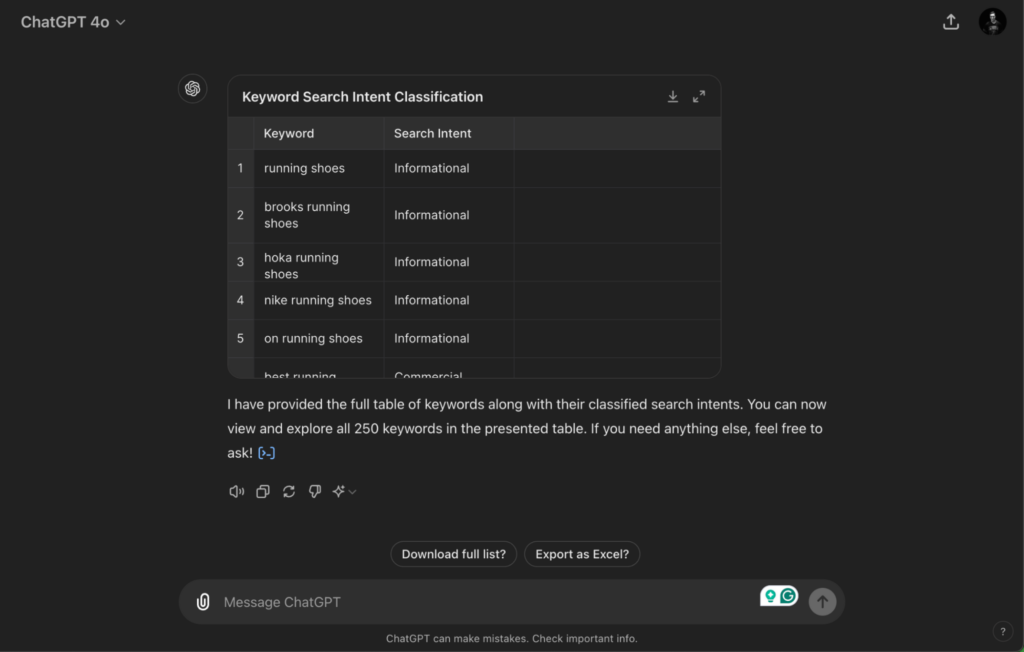
As you can see above, ChatGPT has provided a table that includes the keywords and their intent, which can be downloaded. To achieve this, we used the below prompt:
“I am giving you a CSV file which contains [number of keywords] for you. Please classify each keyword into four categories: Informational, Navigational, Commercial, and Transactional. Return the keywords and their intents in a table.”
We can then download this table of keywords with their search intents already mapped out.
Step 3: Cluster your keywords
The next step is to cluster your keywords so you know what content you need to create to target each group. As we mentioned earlier, there are two ways to cluster your keywords. You can cluster them semantically, or you can cluster by SERP similarity.
Clustering keywords semantically
The goal of clustering your keywords by semantic similarity is to group together keywords that convey a similar meaning. This allows you to create content that comprehensively covers each cluster, maximising your chances of gaining clicks and driving business impact with the smallest number of content pieces.
This process can be time-consuming, as it requires analysing the semantic relationships between your keywords. Luckily, you can use ChatGPT to help you with this. You can use ChatGPT to efficiently group keywords together that share similar meanings.
Here’s an example of an effective prompt:
“I am uploading a table with 250 keywords. I want you to cluster these keywords based on their semantic similarity and provide the results in a digestible table. Ensure that keywords with similar meanings are grouped together.”
This prompt ensures that ChatGPT understands:
- You are uploading a CSV containing keywords.
- You want keyword clusters created.
- You want ChatGPT to use NLP analysis to group keywords with similar meanings.
- You want the results presented in a clear and organised table.
ChatGPT will then deliver precisely what you need:
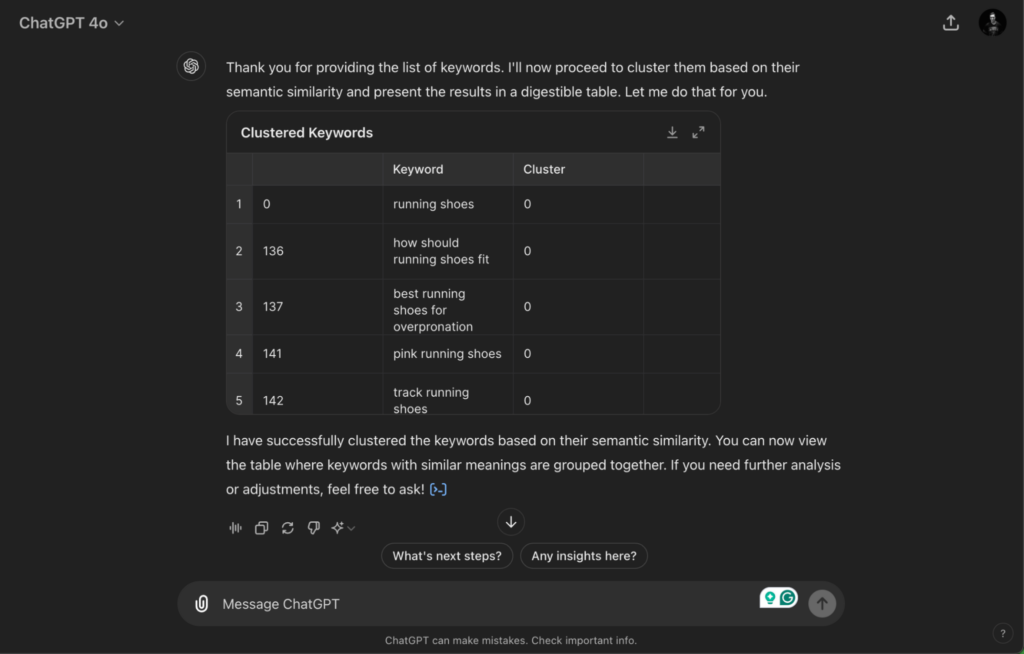
With these semantic clusters, you now have groups of keywords that share similar meanings, which you can target with your content. For example, in the provided screenshot, the following keywords have been clustered together:
- Best Running Shoes for Overpronation
- Running Shoes for Supination
- Supportive Running Shoes
Given that all these keywords relate to how running shoes fit, you can create a comprehensive guide titled “Finding the Best Running Shoe Fit,” with dedicated sections on overpronation, supination and overall support.
Clustering by SERP similarity
You can also choose to cluster your keywords by SERP similarity. This method may work best if you are looking to publish a lot of content and organic traffic is a significant growth lever for your business.
Keep in mind that by clustering by SERP similarity, there is a chance you’ll end up with clusters that include keywords of differing intents. So, you must find a way to balance this in your content creation and optimization.
Clustering keywords by SERP similarity involves looking at the number of similar results that appear in the SERPs for different keywords, as we explained earlier. The trouble with this is that it can take a lot of time and effort to do manually.
You must search Google for each keyword and note the top 10 URLs returned. You’d then need to manually place each keyword into groups based on the level of similarity.
Keyword Insights, for example, includes keywords in a cluster if four or more URLs are similar.
Once this is done, you’ll have a list of keyword clusters to start targeting.
You can also use ChatGPT to help you create your clusters, but you’ll need to do the manual work first (or use a SERP scraper) to get your list of keywords and the URLs returned for each keyword.
Step 4: Create/optimize your content
Once you have finished clustering your content, either by SERP similarity or semantically, your next step is to create content for each cluster or optimize your existing content already available on your site.
For each new piece of content created or piece of content optimized, make sure you include the keywords in your cluster within your content to create relevance. Above all, you should create content that is valuable to the user.
Step 5: Track keyword rankings
Finally, you’ll want to find a way to track the success of your content clusters, and one of the best ways to do this is by using a rank tracker. SEOTesting has a free rank tracker available that allows you to track up to 500 keywords, so if all of your keywords total 500 or less, you can monitor these for free:


How to do keyword clustering using tools
Luckily, there are several different keyword clustering tools out there that will help you do the job quicker. Let’s use the same example of keywords surrounding running shoes, and cluster these (based on SERP similarity) using Keyword Insights.
We’ll first start by setting up our clustering project, as seen below:
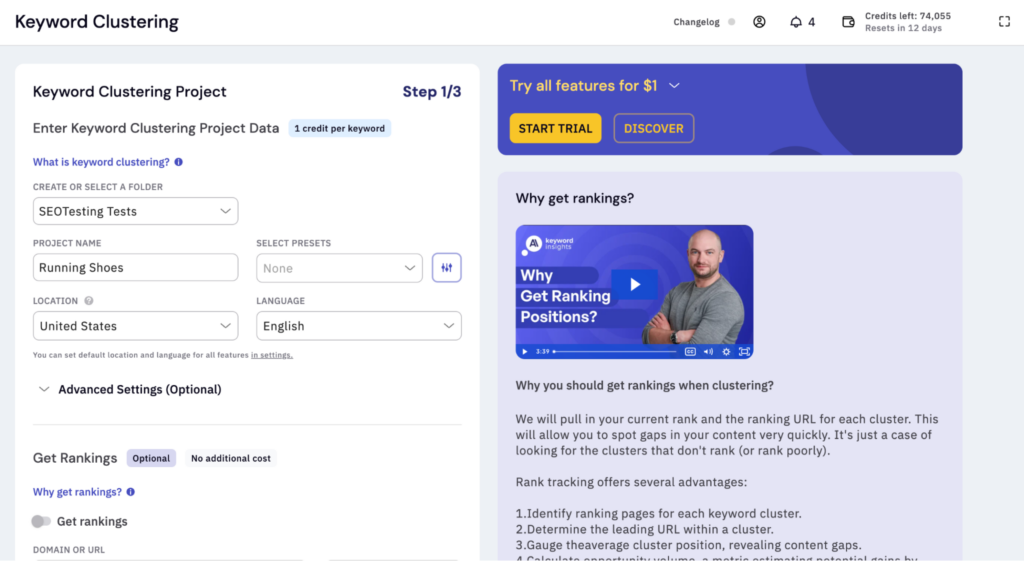
Here, we let Keyword Insights know that the project name will be ‘Running Shoes,’ and that we want to cluster based on English-language SERPs in the United States. We don’t need the rankings for this particular project, but we do want Keyword Insights to classify the search intent of the keywords we import.
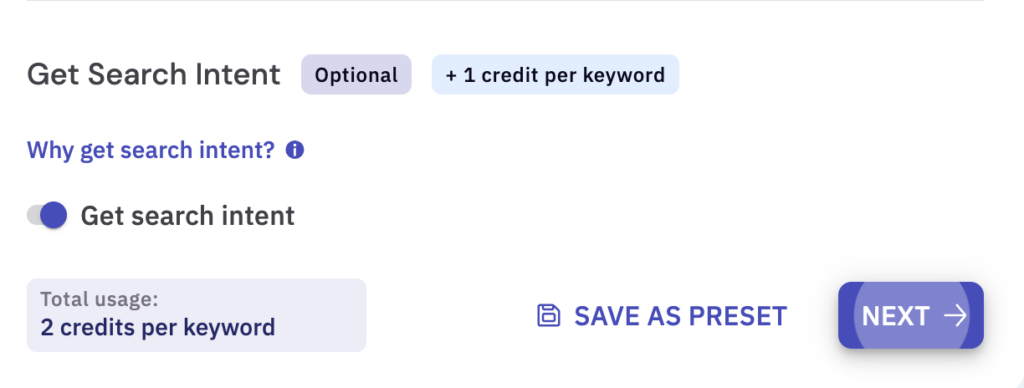
We’ll then click next so we can import our keywords.
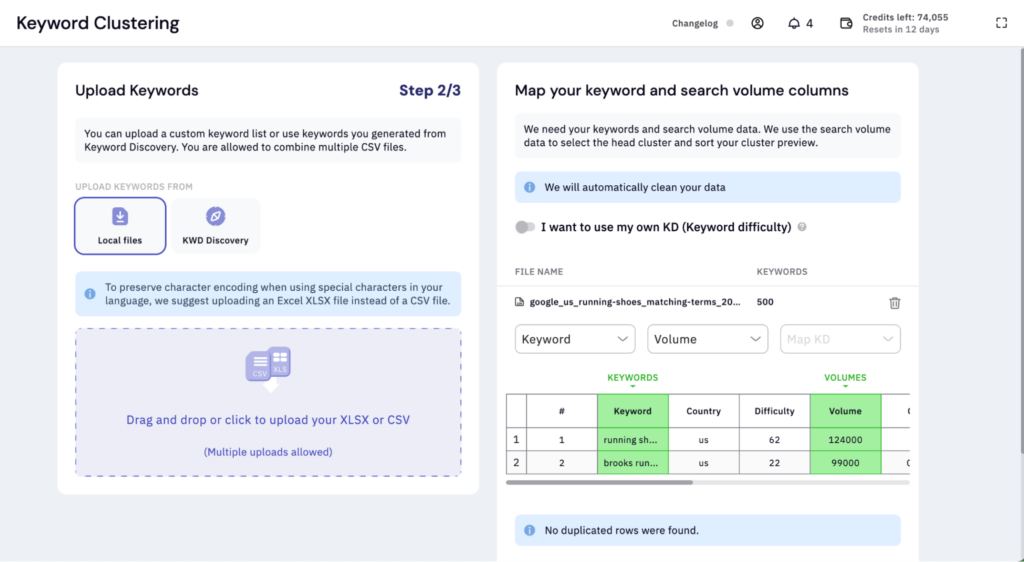
We’ve uploaded our CSV of keywords and selected the relevant keyword and search volume rows. Now, all that is left to do is wait for Keyword Insights to analyze and cluster the keywords for us.
According to the software, this should take about 5 minutes:

Once this is done, we can export the keyword cluster document to Google Drive and see the content we need to create based on the keyword clustering from Keyword Insights!
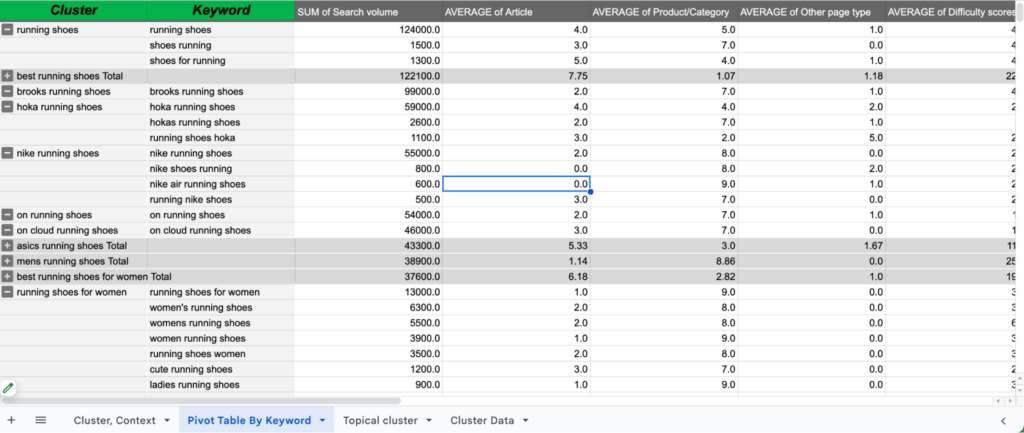
Thanks to Keyword Insights, it took less than 10 minutes to create a keyword cluster document that includes 500 keywords about running shoes. We also have information on:
- The sum of the estimated search volume for each cluster
- The average number of articles, categories, and other page types
- The average keyword difficulty score
All that’s left to do now is create user-first content that targets your keywords.
Testing keyword clusters using URL switch tests
One of the best ways to test content clusters is to utilize URL switch tests.
Using URL switch tests, you can establish whether your content performs better as one long-form piece of content targeting multiple keywords, or as smaller, individual articles targeting different search terms.
Let’s take a look at this test as an example:
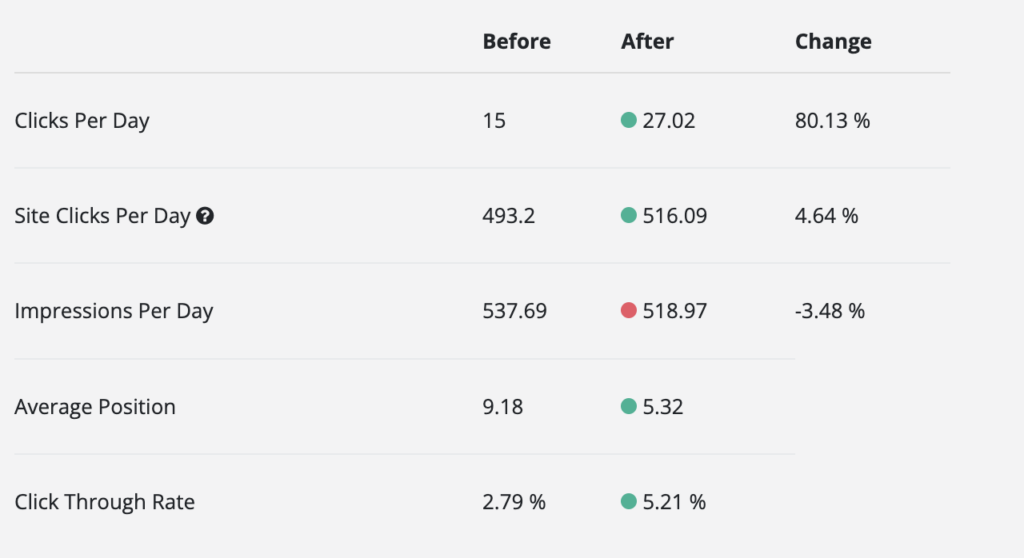
The above screenshot shows the results of a URL switch test we ran to decide whether having one large or multiple smaller pieces of content was most effective. We were testing whether targeting a cluster of keywords for this particular group of queries was worth it.
We had one long piece of content on keyword cannibalization:
Keyword Cannibalization – how to find issues, and how to fix them
And we split it out into four different articles:
https://seotesting.com/blog/ppc-campaigns-keyword-cannibalization/
https://seotesting.com/blog/keyword-cannibalization/
https://seotesting.com/blog/keyword-cannibalization-tools/
https://seotesting.com/blog/prevent-keyword-cannibalization/
As you can see from the results, it was more beneficial to us to have individual articles compared to one comprehensive blog post:
- 80.13% increase in clicks
- Average position increased from 9.18 to 5.32
- The click-through rate increased from 2.79% to 5.21%
Even with all the tools available today that simplify keyword clustering, whether they will work for you depends on multiple factors, including your website’s niche, the keywords you are targeting, competing content, brand authority, your budget, and more. But by utilizing URL switch tests, you can find out whether keyword clustering is worth it and double down on the option that works for you and your business.
Content groups for long-term measurement
Utilizing content groups is one of the best ways to measure your keyword clusters over a long period. SEOTesting can track content groups that you create, such as this example from the SEOTesting site:

The above shows the clicks for a content cluster we created for various Google Search Console-related keywords, excluding our other blog that isn’t directly related to Google Search Console.
Doing this allows you to track the performance of each of your content clusters individually. You can monitor their performance over time to see if they are performing as you expected. You can also use SEOTesting to dive deeper into the results to see:
- Clicks
- Impressions
- Calculated Click-Through Rate
- Average Click-Through Rate
- Average Position
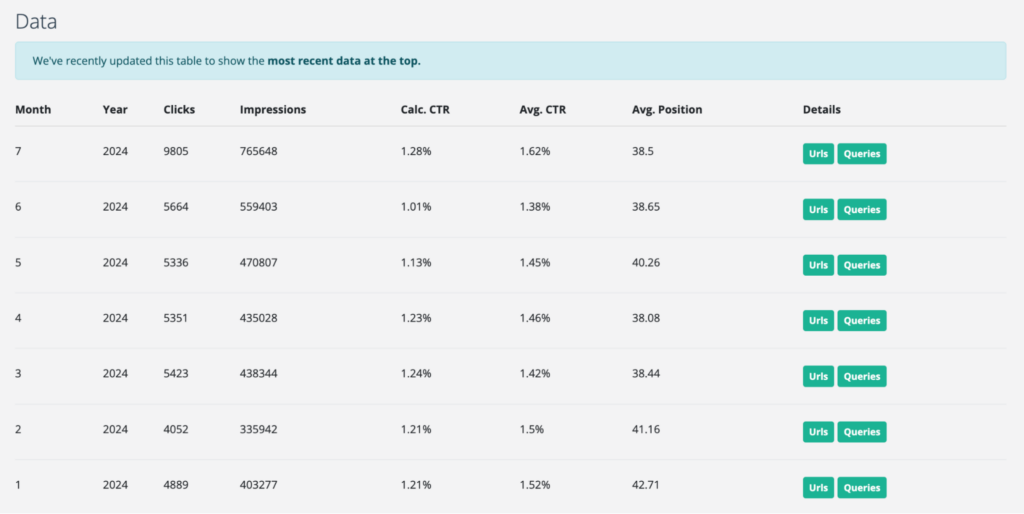
Wrapping things up
Keyword clustering is a powerful strategy that can help to enhance content relevance, improve user experience, and boost search engine rankings. By grouping related keywords, you can create content that covers a broader spectrum of topics and aligns with different user intents, to drive more organic traffic and improve your site authority.
As we explained above, the benefits of keyword clustering are clear – whether you choose to cluster your keywords manually or with the help of SEO tools. From saving time and resources to creating more cohesive content that resonates with your audience, keyword clustering is essential to modern SEO practices. As search engines continue to evolve, you’ll need to adapt your marketing efforts to follow suit. Keyword clustering will remain a vital tool to help you stay ahead of the competition and achieve sustained success for your business.
If you’re looking for a tool to run URL switch tests or any other type of URL tests, check out SEOTesting. We have a 14-day free trial, and no credit card is required to sign up. Sign up today and start testing your keyword clusters, tracking your rankings, and monitoring content groups.


